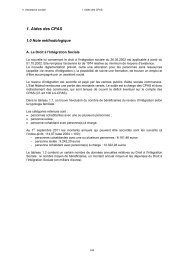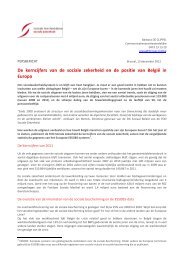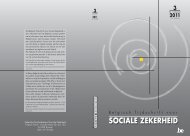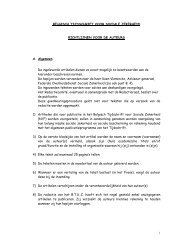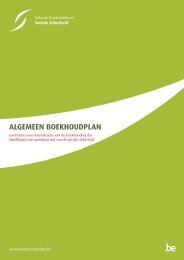Numéro 2/2001 (.pdf) - FOD Sociale Zekerheid
Numéro 2/2001 (.pdf) - FOD Sociale Zekerheid
Numéro 2/2001 (.pdf) - FOD Sociale Zekerheid
- No tags were found...
Create successful ePaper yourself
Turn your PDF publications into a flip-book with our unique Google optimized e-Paper software.
ABSTRACTS« L’euro : un instrument au service de l’emploi ? »par David AubinL’euro a été lancé le 1er janvier 1999, sans grande évocation des bénéfices attendus.Cet article met en évidence les liens entre la monnaie unique et l’emploi, tels qu’ilsapparaissent dans les discours institutionnels européens. A l’issue d’une comparaisonentre les plans Werner de 1970 et Delors de 1989 sur la réalisation de l’Unionéconomique et monétaire, nous identifions une rupture dans l’imaginaire politiqueeuropéen. Alors que le plan Werner considère l’UEM comme un instrument de maîtrisede la conjoncture économique, le plan Delors se focalise sur la stabilité monétaire.Suivant cette logique, le traité de Maastricht met en place une politique économiquede stimulation de l’offre qui associe la lutte contre l’inflation et la réductiondes salaires, en vue d’accroître la rentabilité du capital. La lutte contre le chômagese réduit alors à des actions structurelles. Le choix en faveur de cette politique del’offre remonte au Conseil européen de mars 1979 et ne fut jamais remis enquestion. Depuis lors, l’entreprise est désignée comme le seul acteur du développementéconomique. La stratégie européenne pour l’emploi, développée dans ce contextedepuis 1993, ne peut avoir qu’une portée bien limitée sur le bien-être des salariéseuropéens.« The euro : an instrument to help employment ? »by David AubinThe Euro was launched on 1st January 1999, without much reference to the advantagesthat were expected from it. This article sets out the links between the singlecurrency and employment as stated in European institutional treatises. After comparingthe Werner plan of 1970 and the Delors plan of 1989 on achieving economicand monetary union, we see that there was a break in European policy thinking.Whereas the Werner plan considered the EMU as an instrument for controlling theeconomic conjuncture, the Delors plan focused on monetary stability. In accordancewith this logic, the Maastricht Treaty put in place an economic policy of stimulatingsupply allied to the fight against inflation and the reduction of salaries, with aview to increasing returns on capital. The fight against unemployment was thusreduced to certain structural initiatives. The choice in favour of this policy of supplydates back to the European Council of March 1979 and has never been questioned.Ever since, business has been designated as the sole actor on the stage of economicdevelopment. The European employment strategy which has been developed in thiscontext since 1993, can only have a very limited impact on the well-being of Europeanemployees.** *495



